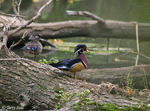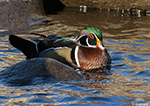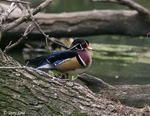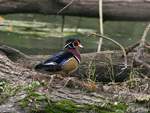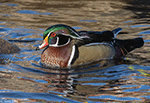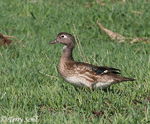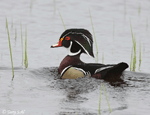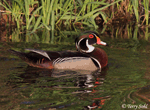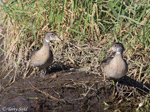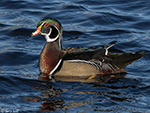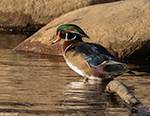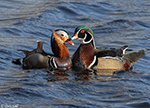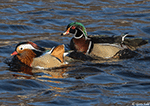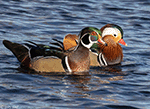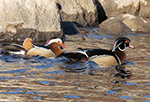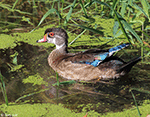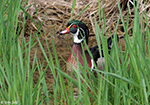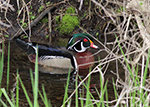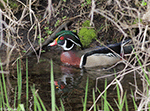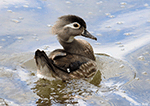| Length: 18 inches | Wingspan: 28 to 30 inches | Seasonality: Summer |
| ID Keys: Male unmistakable, female dull with white eyepatch and white chin | ||
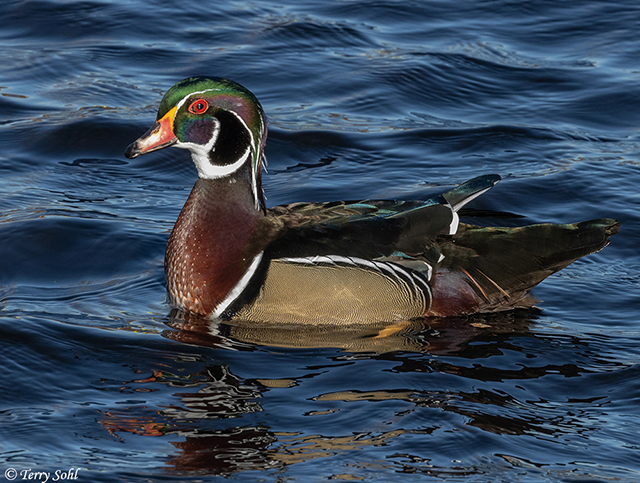 Wood Ducks are probably the most
colorful duck found in the state.
Unlike most duck species, they nest in trees. With heavy hunting pressure
in the 19th century, and habitat destruction that decimated available nesting
cavities, numbers plummeted by the early 20th century and Wood Ducks populations
were in danger. They have been increasing in numbers in recent decades, helped
greatly due to the huge numbers of nest boxes
built especially for them. They are more common in the eastern half of the
state.
Wood Ducks are probably the most
colorful duck found in the state.
Unlike most duck species, they nest in trees. With heavy hunting pressure
in the 19th century, and habitat destruction that decimated available nesting
cavities, numbers plummeted by the early 20th century and Wood Ducks populations
were in danger. They have been increasing in numbers in recent decades, helped
greatly due to the huge numbers of nest boxes
built especially for them. They are more common in the eastern half of the
state.
Habitat:
Shallow lakes, ponds, marshes surrounded by trees. Requires cavities for nesting
Diet:
Mostly vegetable matter such as aquatic plants and seeds, also tadpoles, insects, and snails.
Behavior:
Forages in the water by swimming on the surface, and submerging its head and neck in search of food. Wood Ducks will also forage on land.
Nesting:
April through June in South Dakota. Wood
Ducks are cavity nesters, unable to excavate their own cavity, so reliant on
natural tree cavities or those made by other species. They normally select a
cavity in a large tree, with the cavity anywhere from 3 to more than 50 feet
from the ground. While the nesting site is often close to water, it may be
up to a mile away from water if that's the only available nesting cavity.
The female lines the nesting cavity with down from her own body, and lays
between 5 and 15 eggs. Incubation takes between 26 and 35 days. The young
leave the nest about a day after hatching and gather their own food,
although they are protected and tended by the mother. The young are able to
fly about 2 months after hatching.
Wood Ducks have benefited greatly by the placement of specially made nesting
boxes, enabling nesting in areas where natural tree cavities have become
scarce.
Song:
The most commonly heard sound from a wood duck is the alarm call as they flush. That alarm call is a series of multiple, loud, multi-tone calls that rise in pitch. Males also have a much more subtle whistling call.
- Click here to hear the typical alarm call of a Wood Duck1
- Click here to hear the subtle whistled calls of a male Wood Duck2
- Click here to hear mixed calls (and loud alarm calls) of Wood Duck3
Migration:
Winters in the southeastern United States, the Pacific Coast, and Mexico.
Interactive eBird map:
Click here to access an interactive eBird map of Wood Duck sightings
Similar Species:
Female similar to other female ducks
Birdhouses:
Will use nest boxes built for Wood Ducks.
Conservation Status:
In decline at the start of the 20th century, they've expanded in numbers and range, in large part due to the numbers of nest boxes created. They're common in many parts of their range, and are found over a broad geographic area. The IUCN considers the Wood Duck to be a species of "Least Concern".
Further Information:
- USGS Patuxent Bird Identification InfoCenter, Wood Duck
- BirdWeb - Wood Duck
- Audubon Field Guide - Wood Duck
- Whatbird.com - Wood Duck
Photo Information:
November 15th, 2020 -- Yankton, South Dakota -- Terry L. Sohl
Additional Photos:
Click on the image chips or text links below for additional, higher-resolution Wood Duck photos. Note that many of the photos below include an odd couple from Yankton, South Dakota, in the late fall of 2020, when a Mandarin Duck and Wood Duck drake were found hanging out together for several weeks.
Audio File Credits:
- 1Antonio Xeira. Recorded in Metro Beach Metropark in Michigan on August 7th, 2016. Original file and information available from xeno-canto.
- 2Paul Marvin. Recorded in Oxbow National Wildlife Refuge in Massachusetts on May 16th, 2012. Original file and information available from xeno-canto.
- 3Russ Wigh. Recorded in Skidaway Island in Georgia on February 26th, 2017. Original file and information available from xeno-canto.
| Click on the range map for a higher-resolution view |
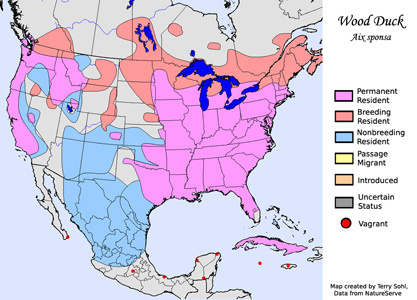 |
| South Dakota Status: Common summer resident in the eastern part of the state, uncommon in the west. Rare in winter. |
Additional Wood Duck Photos
Click for a higher-resolution version of these photos
